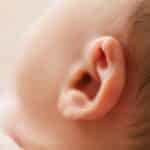When you have a baby, childproofing goes with the territory. You may be surprised at what trouble babies and toddlers can get into. They can be very curious and sneaky in the way they open drawers and get into things they shouldn’t!
While many people know that they have to childproof their home, many are unsure how to childproof their home. It involves much more than just putting up a baby gate and calling it a day. Each room in your home involves specific attention to potential dangers in that room.
If you want to know how to childproof your home, read on for our room-by-room guide of what you should do to make your home as safe as it can be for your child.
Think Like a Baby
You want to see what a child sees as they move about your home. To do this, you’re going to need to get on their level…literally. As silly as it may sound, get on your hands and knees, crawl around your house and see what’s easily in reach of your child. Doing this will put things like knickknacks in reach as well as cords for blinds.
As you’re looking around the house, don’t forget the little things. Big things like putting up a baby gate are obvious, but what about those kitchen magnets? Don’t you think that kids will want to grab those and see what they’re all about?
Also, don’t forget the obvious. Cleaning supplies should be locked away and any houseplants should be kept out of reach. Not only are the cleaning supplies dangerous for obvious reasons, but don’t put it past your child to take a bite out of your favorite houseplant before he knocks it over.
What you need to Childproof in Every Room of Your Home
While every room in your home will have its specific safety needs, there are basics things you should be on the lookout for in every room.
How to Childproof Stairs
View in gallery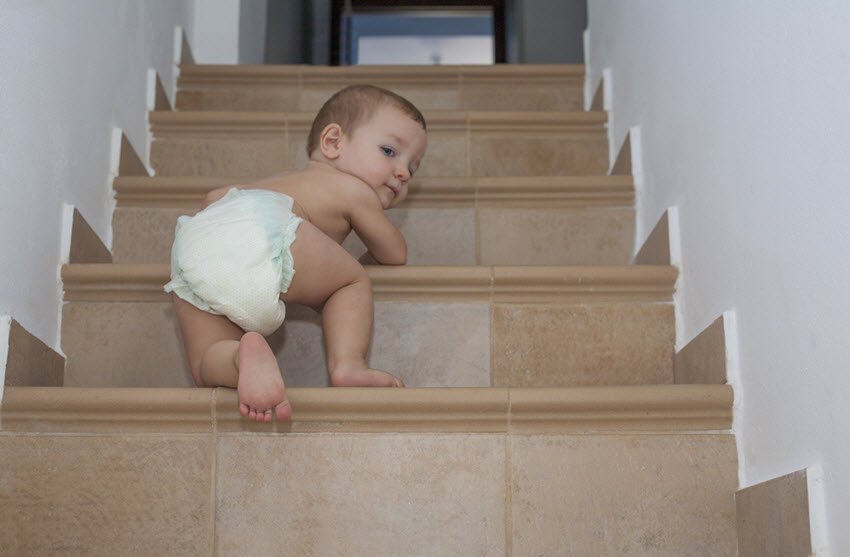
The stairs pose a huge danger because kids can easily tumble down them and injure themselves. Gates should be installed at the top and bottom of any staircases that your kids may have access to. One gate we especially like is the Regalo Easy Step Gate.
[amalinkspro type=”showcase” asin=”B001OC5UMQ” apilink=”https://www.amazon.com/dp/B001OC5UMQ?tag=mominformedcom-20&linkCode=osi&th=1&psc=1″ new-window=”true” addtocart=”false” nofollow=”true” sc-id=”4″ imgs=”LargeImage” link-imgs=”false” specs=”EXTRA WIDE: Expands to fit openings between 29-34 and 35-38.5 inches wide. Stands 30 inches tall. Please be sure measure your opening prior to purchase to ensure proper fit. Note: This gate will not fit an opening between 34-35 Inch.~~~EASY TO USE AND SET UP: Pressure mount design that is quick to set up. Please note, before installation there will be a gap between the gate latch and the frame which is NOT a defect and it is NOT bent. This gap will be eliminated once installed.~~~ADJUSTABLE: Includes a 6-inch wide extension kit and 4 pressure mount spindle rods. Perfect for doorway, hallway and bottom of stair use. Gate can quickly be removed out of the opening for easy storage. Additional extensions sold separately.~~~~~~~~~” btn-color=”#ff9900″ btn-text=”Buy on Amazon” alignment=”aligncenter” hide-prime=”0″ hide-image=”0″ hide-reviews=”0″ hide-price=”0″ hide-button=”0″ width=”750″]Regalo Easy Step 38.5-Inch Extra Wide Walk Thru Baby Gate, Includes 6-Inch Extension Kit, 4 Pack Pressure Mount Kit, 4 Pack Wall Cups and Mounting Kit[/amalinkspro]
Be sure that all gates lock appropriately and don’t allow your kids to open them. You may be surprised at just how crafty those little hands can be to open baby gates.
How to Childproof Windows with Guards
View in gallery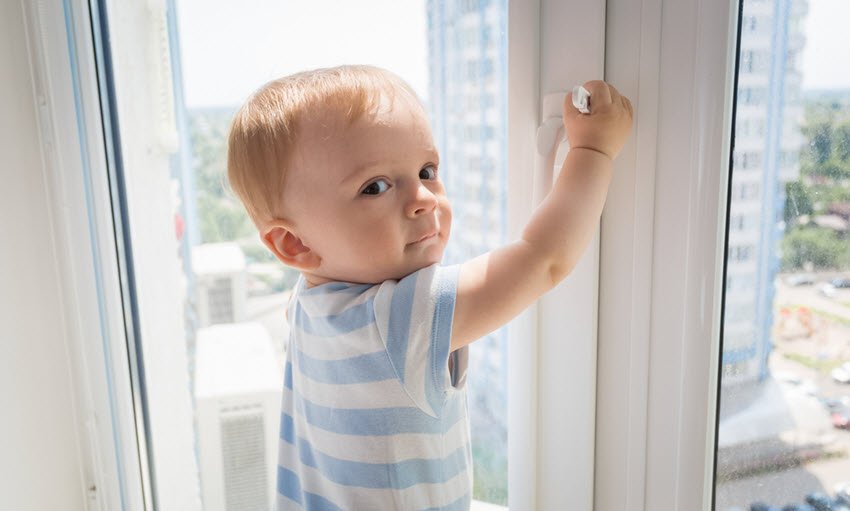
It only takes a split-second to look away for a child to get near a window and potentially fall out. A window gate or guard can help prevent that type of tragedy. While you want there to be protection for babies, you also want the windows to still open in case of a fire.
If you’re looking for a window guard, Safety Innovations makes a product that many parents seem to like. You always want to look for one that is strong enough to prevent a fall but can still be opened in case of fire. Many people think that having a window screen is enough to protect their kids from falling out of windows. But, the screens are not sturdy enough. Kids can easily push through the screens and out the window.
[amalinkspro type=”showcase” asin=”B072LTXL6V” apilink=”https://www.amazon.com/dp/B072LTXL6V?tag=mominformedcom-20&linkCode=osi&th=1&psc=1″ new-window=”true” addtocart=”false” nofollow=”true” sc-id=”4″ imgs=”LargeImage” link-imgs=”false” specs=”MOM AND DADS AGREE SAFETY IS FIRST: We know you put your babys safety at the top of your list. Thats why youll appreciate our Safety Innovations Window and Door Safety Stop. This helpful device keeps windows, sliding glass doors, sliding shower doors and mirrored sliding closet doors locked to keep your baby safe.~~~YOUR BABYS SAFETY IS OUR #1 PRIORITY TOO: We know how curious kids are! Our goal is to help all moms and dads keep their kids safe. Our Window and Door Safety Stop keeps windows and sliding glass doors locked to prevent window falls and to keep your children from wandering into unsafe areas.~~~~~~~~~~~~” btn-color=”#ff9900″ btn-text=”Buy on Amazon” alignment=”aligncenter” hide-prime=”0″ hide-image=”0″ hide-reviews=”0″ hide-price=”0″ hide-button=”0″ width=”750″]Safety Innovations – Childproof Your Windows and Sliding Doors with Our Window and Door Babyproof Safety Lock, (4-Pack)[/amalinkspro]
How to Childproof Doors
It won’t take long for your child to open a door and make a run for it. That’s why doorknob covers are a staple of the childproofing process. Doorknob covers make it hard for little hands to turn the door handles. They should be placed on all entry doors as well as closet doors. Some people also put them on bathroom doors, but let’s be real. When you’re a parent, your bathroom privacy goes out the door. So, if you’re putting them on doors for that reason, that could be a lost cause. But, you can still put them on bathroom doors so that your child doesn’t toilet paper your bathroom or mistake the toilet for a water fountain. Yuck!
Doorknob covers are easy to install and inexpensive.
[amalinkspro type=”showcase” asin=”B01K3SOW98″ apilink=”https://www.amazon.com/dp/B01K3SOW98?tag=mominformedcom-20&linkCode=osi&th=1&psc=1″ new-window=”true” addtocart=”false” nofollow=”true” sc-id=”4″ imgs=”LargeImage” link-imgs=”false” specs=”★Special Design—Special double button design with soft TPR material increased friction with the door knob. When you need to open the door,press the double buttons and turn the door knob easily.~~~★Easy Installation/Release—No drill and tools need,no harm to the door.Take off the door knob cover then set it on the door knob and close the two covers,the door knob is in lock.It can be easily released by a screwdriver.~~~★Why need it—Prevent babies from opening the door and getting into dangers like the toilet or the storeroom and get injured;Prevent babies from going in or out of the house without adults superision; Prevent children from playing with the door and pinching their fingers.~~~~~~Please note that this product has been updated, with only a little difference in appearance, but no change in function. You may receive products both in old version and the new version, but the function is completely the same, please feel free to purchase.~~~” btn-color=”#ff9900″ btn-text=”Buy on Amazon” alignment=”aligncenter” hide-prime=”0″ hide-image=”0″ hide-reviews=”0″ hide-price=”0″ hide-button=”0″ width=”750″]EUDEMON 4 Pack Baby Safety Door Knob Covers Door Knob Locks[/amalinkspro]
You can also buy pinch guards to prevent your child from getting their hands stuck in between doors. They are inexpensive and come in multi-packs.
[amalinkspro type=”showcase” asin=”B07735SH26″ apilink=”https://www.amazon.com/dp/B07735SH26?tag=mominformedcom-20&linkCode=osi&th=1&psc=1″ new-window=”true” addtocart=”false” nofollow=”true” sc-id=”4″ imgs=”LargeImage” link-imgs=”false” specs=”Child Safety Door Pinch Guards are made from soft EVA foam, prevents the doors from closing on your curious child, baby, and even pets.~~~Prevent Injuries, stop doors from slamming & prevent child or pet from getting locked out.~~~Baby Proof your doors in seconds: Place the Pinch Guard on the side or on top of the door.~~~Soft EVA foam door stopper to prevent damage to your doors.~~~Manufacturers lifetime warranty covering defects~~~” btn-color=”#ff9900″ btn-text=”Buy on Amazon” alignment=”aligncenter” hide-prime=”0″ hide-image=”0″ hide-reviews=”0″ hide-price=”0″ hide-button=”0″ width=”750″]Door Pinch Guards (6 Pack) Baby Proof Doors Extra Soft Foam, Sleek Design, Child Safety, Baby Safety Finger Protectors by Jool Baby[/amalinkspro]
How to Childproof Rugs
As your child learns to walk, they’ll be falling all over the place. When they do learn how their little legs work, they’ll be off and running. Any rugs that are not secured to the floor pose a fall hazard. Grippers and non-stick pads are easy solutions for securing rugs. These will even benefit you so that you don’t fall as you’re running after your toddler.
How to Childproof Outlet Covers
View in gallery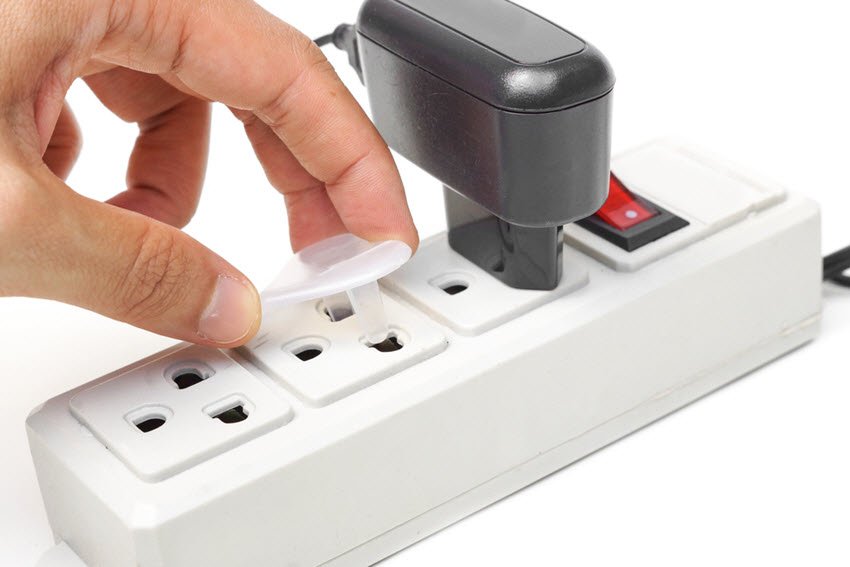
Outlet covers are a must. These need to be put in every room of your home. Children’s fingers are tiny and so are outlets. They can easily try to stick their fingers inside the outlet or try to see what else can fit in them. The great thing about outlet covers is that they come in a multi-pack so they are very inexpensive. Once your child outgrows this stage (this will take a while), you can take the covers out just as easily as you put them in.
[amalinkspro type=”showcase” asin=”B00081J3N6″ apilink=”https://www.amazon.com/dp/B00081J3N6?tag=mominformedcom-20&linkCode=osi&th=1&psc=1″ new-window=”true” addtocart=”false” nofollow=”true” sc-id=”4″ imgs=”LargeImage” link-imgs=”false” specs=”Individual Outlet Caps~~~Prevents accidental shock~~~36 Pack~~~No tools required to install~~~” btn-color=”#ff9900″ btn-text=”Buy on Amazon” alignment=”aligncenter” hide-prime=”0″ hide-image=”0″ hide-reviews=”0″ hide-price=”0″ hide-button=”0″ width=”750″]Mommy’s Helper Outlet Plugs, 36 Count[/amalinkspro]
Besides these items, there are several other basic childproofing measures you’ll want to take to make sure your home is safe. Here is a checklist to go through so that you can make sure you have the basics covered.
- Make sure there are smoke detectors on every level of your home as well as in all bedrooms
- Have carbon monoxide detectors near sleeping areas in your home
- Make sure all window blind cords are out of the reach of children to prevent a strangulation hazard
Those are the simple things that need to be done in each room to keep your child safe. Now, let’s go room by room to see how to childproof your home to keep your baby out of harm’s way.
How to Childproof the Kitchen
The kitchen can pose numerous risks for your child. When you want to know how to childproof your home, start here. You may even want to put a baby gate in the entrance of your kitchen if your space allows. This will keep the kitchen off-limits when you’re not around. Everyone just needs to be mindful to close the gate when they leave the room.
How to Childproof Cabinet Locks
View in gallery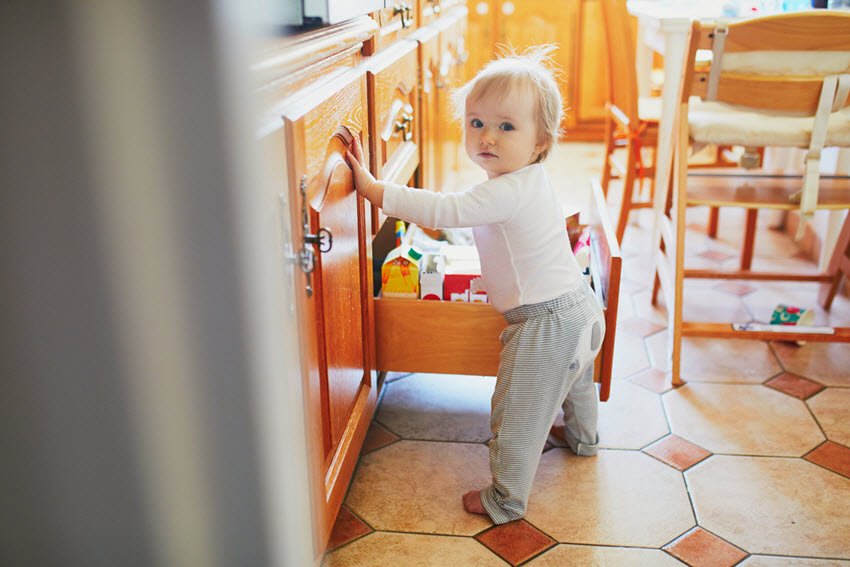
With cabinets full of pots, pans, utensils, and other gadgets, your kitchen is full of potential dangers for your child. That’s one of the first things you need to do is get cabinet locks. You don’t want your baby getting into any mixers or dangerous items. You also don’t want all of your pots, pans, and containers all over the kitchen floor.
There are three basic types of locks for your kitchen cabinets, magnetic, internal, and external locks. The external locks look like ties that keep your handles together so that children can’t open them. The external locks are less expensive but you have to remember to always tie them together when you’re done.
[amalinkspro type=”showcase” asin=”B074FW21SM” apilink=”https://www.amazon.com/dp/B074FW21SM?tag=mominformedcom-20&linkCode=osi&th=1&psc=1″ new-window=”true” addtocart=”false” nofollow=”true” sc-id=”4″ imgs=”LargeImage” link-imgs=”false” specs=”Adjustable With an extra-long U-shaped latch, the maximum lock length is up to 5 inches. This allows you to flexibly adjust the lock to different handles and configurations.~~~Easy Installation, No tools or drills needed. Easily finish the installation in seconds. No-adhesive design helps to conveniently remove the lock without leaving marks on the furniture. Squeeze both buttons simultaneously to unlock, which is easy for adults but certainly difficult for babies.~~~~~~~~~~~~” btn-color=”#ff9900″ btn-text=”Buy on Amazon” alignment=”alignnone” hide-prime=”0″ hide-image=”0″ hide-reviews=”0″ hide-price=”0″ hide-button=”0″ width=”750″]Adoric Sliding Cabinet Locks, U Shaped Baby Safety Locks, Childproof Cabinet Latch for Kitchen Bathroom Storage Doors, Knobs and Handles (4-Pack, White)[/amalinkspro]
The internal locks require you to screw into your cabinets and have a latch to open them. Some people don’t like to screw the locks to their cabinets because their children will eventually grow and they won’t need them anymore.
[amalinkspro type=”showcase” asin=”B078B8T4R9″ apilink=”https://www.amazon.com/dp/B078B8T4R9?tag=mominformedcom-20&linkCode=osi&th=1&psc=1″ new-window=”true” addtocart=”false” nofollow=”true” sc-id=”4″ imgs=”LargeImage” link-imgs=”false” specs=”Cabinet Door Locks: Curious kids love to explore, is your home ready? Thanks to their universal fit, our cupboard locks are perfect for most cabinets and drawers! You’ll receive 8 locks and catch plates, so you can baby proof the kitchen, bathroom and more.~~~Easy to Use: While similar products rely on keys or magnets, our spring action design opens with a single press! Easy for adults but secure against kids, they keep your little one safe. A great match for any home, you’ll safeguard a room without sacrificing style.~~~Install in Seconds: With pre-applied adhesive, installing our child proof locks requires no tools or measuring! Just stick them in place for a reliable hold that won’t damage furniture. Purchase also includes optional mounting hardware, providing extra security.~~~~~~~~~” btn-color=”#ff9900″ btn-text=”Buy on Amazon” alignment=”alignnone” hide-prime=”0″ hide-image=”0″ hide-reviews=”0″ hide-price=”0″ hide-button=”0″ width=”750″]Spring Action Baby Proofing Cabinet Locks (8-Pack) – Easy to Install Child Proof Cabinet Locks, Tool-Free Installation – Optional Mounting Hardware and Extra Adhesive Included (White, 8)[/amalinkspro]
There are also magnetized locks that also require you to screw in or attach a magnetized piece on the inside of the cabinet while you have a magnetized piece to open it. These are very secure because you have to use your magnetized piece in just the right location to open up your cabinet. Sometimes parents even have trouble opening these types of locks!
[amalinkspro type=”showcase” asin=”B07B47PDB4″ apilink=”https://www.amazon.com/dp/B07B47PDB4?tag=mominformedcom-20&linkCode=osi&th=1&psc=1″ new-window=”true” addtocart=”false” nofollow=”true” sc-id=”4″ imgs=”LargeImage” link-imgs=”false” specs=”12 LOCKS + 1 KEY – Baby Proofing Magnetic Cabinet Locks Child Safety – VMAISI 12 Pack Children Proof Cupboard Baby Locks Latches with Adhesive for Cabinet & Drawers with Screws Durable Fixed~~~~~~INVISIBLE FROM OUTSIDE – Cabinet Locks install inside cabinets or drawers, completely concealed from children and guests, making your home more appealing, while cabinet locks child safety also providing ideal child protection.~~~~~~MAGNETIC LOCKING SYSTEM】- Baby Safety Magnetic cabinet locks install on the inside of your cabinet or drawer. The fixings are secured with tape to keep your locks in place. Magnetic keys are provided to disengage the locks. Should you misplace the keys, any strong magnet can be used to disengage the lock.~~~” btn-color=”#ff9900″ btn-text=”Buy on Amazon” alignment=”aligncenter” hide-prime=”0″ hide-image=”0″ hide-reviews=”0″ hide-price=”0″ hide-button=”0″ width=”750″]Baby Proofing Magnetic Cabinet Locks Child Safety – VMAISI 12 Pack Children Proof Cupboard Baby Latches – Adhesive Magnet Drawers Locks No Drilling (White)[/amalinkspro]
How to Childproof Stove Guard
A stoves present a huge hazard for kids because they can get burned if it’s turned on accidentally. Besides using the back burners whenever possible, you may want to invest in a stove guard.
[amalinkspro type=”showcase” asin=”B00005BX4Z” apilink=”https://www.amazon.com/dp/B00005BX4Z?tag=mominformedcom-20&linkCode=osi&th=1&psc=1″ new-window=”true” addtocart=”false” nofollow=”true” sc-id=”4″ imgs=”LargeImage” link-imgs=”false” specs=”Made in China~~~Protect your child against scalds and burns~~~Adjustable to fit all stoves and surfaces~~~Before use,the intended surface should be cleaned and thoroughly dried prior to application~~~The stove guards should be installed with a minimum distance of 1.2in (4cm) from stove burners~~~Remove the guard sections and leave only the clips installed for 24 hours to cure the adhesives~~~~~~The length of the stoveguard can be adjusted in between 24 inches (minimum) to 36 inches (maximum)~~~” btn-color=”#ff9900″ btn-text=”Buy on Amazon” alignment=”aligncenter” hide-prime=”0″ hide-image=”0″ hide-reviews=”0″ hide-price=”0″ hide-button=”0″ width=”750″]Prince Lionheart Adhesive Stove Guard[/amalinkspro]
There are also knob covers so that kids can’t turn the stove on. Some people even take the knobs off when they’re not cooking if the knobs are located at the front of the stove.
[amalinkspro type=”showcase” asin=”B07D5KVQWM” apilink=”https://www.amazon.com/dp/B07D5KVQWM?tag=mominformedcom-20&linkCode=osi&th=1&psc=1″ new-window=”true” addtocart=”false” nofollow=”true” sc-id=”4″ imgs=”LargeImage” link-imgs=”false” specs=”Large design fits more stove knobs than our competition.~~~Dimensions- Diameter: 2.75 | Height: 1.75 | Bottom Hole Diameter: 1.25. View images for reference.~~~Our child safety stove knob covers features a clear design that blends into any style décor.~~~Strong, hinged lid for easy adult access, while remaining baby proof. Durable and heat resistant. Easy to install and remove from your oven.~~~~~~” btn-color=”#ff9900″ btn-text=”Buy on Amazon” alignment=”aligncenter” hide-prime=”0″ hide-image=”0″ hide-reviews=”0″ hide-price=”0″ hide-button=”0″ width=”750″]Clear Stove Knob Covers (5 Pack) Child Safety Guards, Large Universal Design – Baby Proof by Jool Baby[/amalinkspro]
You’ll also want to look at investing in an oven latch. As your child grows they’ll learn that the oven opens. They can not only get burned, but they can also bump their heads with the oven door.
How to Childproof Dishwasher
View in gallery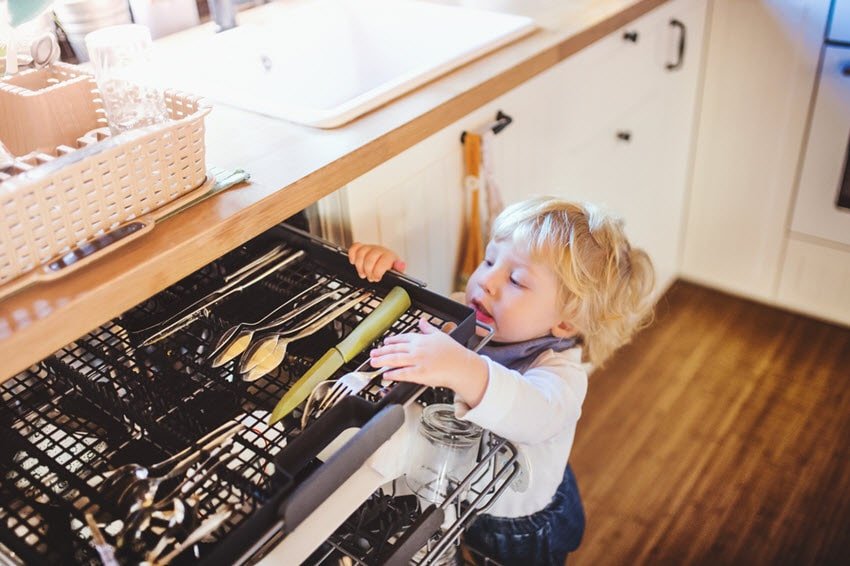
Besides the stove, the dishwasher could also pose a hazard if your child decides to open it and pull out a knife or another dangerous object. Many dishwashers lock when they’re on, so that shouldn’t be an issue. But, even when the dishwasher is loaded, but not on, lock the door. Many dishwashers have this option. Check to see if yours is included.
If your dishwasher is an older model and doesn’t have the option of locking the door, look for an appliance lock that can do the trick.
[amalinkspro type=”showcase” asin=”B072KPZMMV” apilink=”https://www.amazon.com/dp/B072KPZMMV?tag=mominformedcom-20&linkCode=osi&th=1&psc=1″ new-window=”true” addtocart=”false” nofollow=”true” sc-id=”4″ imgs=”LargeImage” link-imgs=”false” specs=”Adjustable straps can child proof Fridges, cabinets, drawers, oven, washer machine, toilets, closet, waste bin, etc.~~~Our baby safety adjustable locks can adjust from 3 to 7. They fit any size appliance and furniture. Flexible strap does NOT use tools or screws.~~~Our Safety Straps use strong 3M adhesive to secure your appliance until youre ready to take it off. (with NO damage)~~~Jool Baby Products is a well known brand that has satisfied many thousands of customers.~~~~~~” btn-color=”#ff9900″ btn-text=”Buy on Amazon” alignment=”aligncenter” hide-prime=”0″ hide-image=”0″ hide-reviews=”0″ hide-price=”0″ hide-button=”0″ width=”750″]Child Safety Strap Locks (4 Pack) for Fridge, Cabinets, Drawers, Dishwasher, Toilet, 3M Adhesive No Drilling – Jool Baby[/amalinkspro]
How to Childproof a Microwave
You may want to move the microwave in your home depending on where it is in the kitchen. If it’s mounted above your oven, no worries. But, if it’s on a counter or a cart, you’ll want to take a second look. Kids can not only start to push buttons wreaking all types of havoc, but they may also try to put something in there and hurt themselves. Move the microwave to a location that is out of reach.
How to Childproof Cutlery
As you’re looking for ways of how to childproof your home, look on your kitchen counter. It can be a playground of danger for kids. Those cutlery blocks that many of us have on our counters need to be completely removed or at least put out of the reach of children. It takes one split-second of you answering a phone call for a child to get access to the cutlery block and grab a knife.
How to Childproof Magnets
Sure, magnets are cute on the fridge. Your child may think so too and try to grab them. They can quickly end up in their mouths, especially the smaller magnetic pieces. It’s best to just keep these objects off the fridge so that your child is not tempted to grab them.
How to Childproof a Refrigerator
View in gallery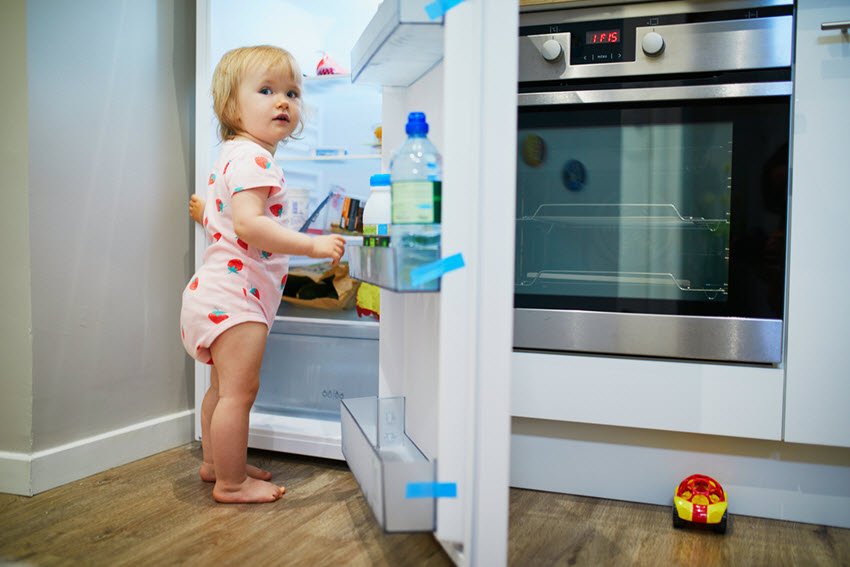
Your child may be able to open the refrigerator depending on the style you have. You may want to consider installing a latch to make it harder for your child to open. As you’re childproofing your fridge, be sure that grapes and other foods that pose a choking hazard are also out of reach.
How to Childproof Tablecloths
While a tablecloth on your kitchen may look nice, in one swoop everything on top of the table can end up on the floor. Babies can easily grab a tablecloth end and pull it. If you have a hot cup of coffee on the table or a vase of flowers they will come crashing down, potentially injuring your baby. As tempting as it may be, skip the tablecloths.
How to Childproof The Living Room
The living room has several hot spots where children can get into trouble and get hurt.
How to Childproof a Fireplace
View in gallery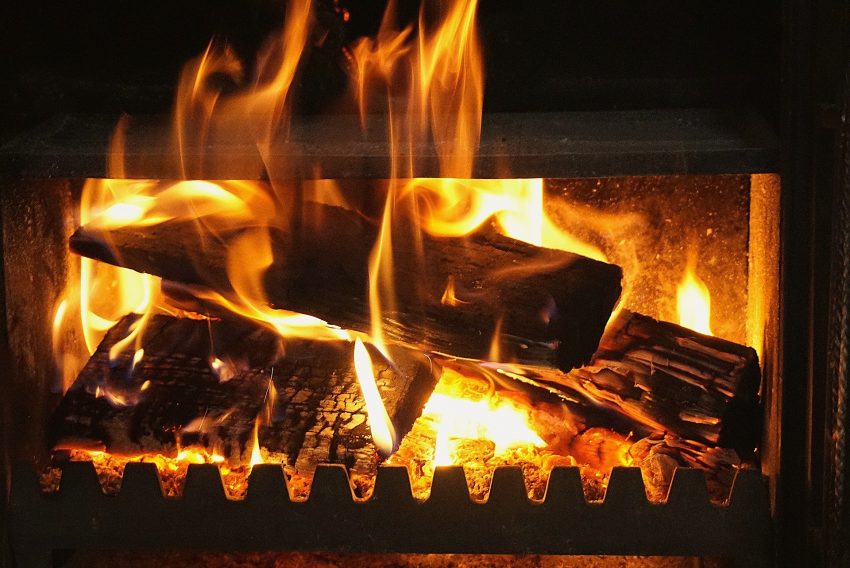
If you have a fireplace in your living room, you’ll want to get a fireplace gate to protect your baby from the flames. Even when using a fireplace gate, never leave your child unattended when a fire is burning. On the subject of fire, sure we all love candles, but candles and kids don’t mix. You may have to skip lighting the candles if you can’t keep them out of the reach of babies. If you put them on a mantle or a high shelf, be sure that the shelf is secure and that there’s no chance the baby can try to knock it down.
How to Childproof Frames
Keeping frames out of a child’s reach is also key when you’re looking at how to childproof your home. If you leave pictures on end tables in the living room and you have a toddler who’s a climber (who doesn’t), those pictures are about two seconds away from crashing and shattering glass all over the floor. As with the candles, keep frames out of the reach of children. This is very important because children may be more prone to grab photos if they see themselves in one or someone they recognize.
How to Childproof a Television
Don’t underestimate your child’s strength. If your television is on a stand that is within reach of your child, there is a chance that it can fall down on top of them. To alleviate this problem, you can mount the television to the wall or by slip-resistant velcro straps. These go through air-vent holes and connect to eye hooks that are screwed into the wall. This gives the television support if your child tries to tip it over.
[amalinkspro type=”showcase” asin=”B01CNXG02I” apilink=”https://www.amazon.com/dp/B01CNXG02I?tag=mominformedcom-20&linkCode=osi&th=1&psc=1″ new-window=”true” addtocart=”false” nofollow=”true” sc-id=”4″ imgs=”LargeImage” link-imgs=”false” specs=”✅ HIGHEST QUALITY FOR THE BEST PROTECTION – Both end plates that secure to the TV/furniture/wall and the cam buckle are made of industry standard metal to ensure the best tip-over protection. The incredible jaw grip prevents sliding and is easily adjustable to loosen or tighten the strap. The straps are detachable for cleaning and moving purposes. Each heavy duty nylon webbing is triple-stitched for extra strength.~~~✅ DETAILED WRITTEN AND VIDEO INSTRUCTIONS – There are 3 possible configurations (TV to furniture, TV to wall, furniture to wall). Instruction manual is included in the packaging. But we don’t stop there… Buyers will be emailed a much more detailed PDF guide, constantly updated FAQs, as well as installation videos to ensure you install it easily and most important of all, correctly.~~~✅ MOST MOUNTING HARDWARE INCLUDED – We include furniture and wall screws, and bolts of different sizes that should take care of most VESA mounting holes. Please check the product description for a detailed list of items that we provide. NOTE: We recommend using 2 straps per piece of furniture.~~~~~~~~~” btn-color=”#ff9900″ btn-text=”Buy on Amazon” alignment=”aligncenter” hide-prime=”0″ hide-image=”0″ hide-reviews=”0″ hide-price=”0″ hide-button=”0″ width=”750″]The Baby Lodge TV and Furniture Anti Tip Straps – Safety Furniture Wall Anchors for Baby Proofing Flat Screen TV, Dresser, Bookcase, Cabinets, and More – All Metal, No Plastic Parts (2 Pack, Black)[/amalinkspro]
The Remote Control
You may be wondering how the remote control can pose a hazard in your home. If the part where the batteries are located is loose or easy to get off, your child can get into that, take the batteries, and put them in their mouth. Batteries can get stuck in the esophagus and cause serious damage. Keep the remote out of your children’s reach at all times.
How to Childproof a Glass Coffee Table
Sure that glass coffee table looked amazing when there were no kids around. Now, any sharp edges make you cringe. Kids can poke their eyes or forehead with the sharp table edges. If getting rid of the table is not an option, you may want to invest in table protectors. These can at least cushion the impact if your child runs into the table.
[amalinkspro type=”showcase” asin=”B0771L5HN5″ apilink=”https://www.amazon.com/dp/B0771L5HN5?tag=mominformedcom-20&linkCode=osi&th=1&psc=1″ new-window=”true” addtocart=”false” nofollow=”true” sc-id=”4″ imgs=”LargeImage” link-imgs=”false” specs=”✅ AUTHENTIC CERTIFIED SAFETY PRODUCT – This product should be used under adults supervision, all our products are tested under strict US regulations. There are no phthalates, BPA, chemicals or added toxic fire retardants (SCCPs).~~~✅ SPECIAL DESIGN AND 1 MINUTE INSTALLATION – Our protectors are designed by Mechanics expert to protect your baby from being hurt by the corners of coffee table,desk,TV cabinets and other sharp corners in the house. And under our instructions, you can easily finish the installation.~~~✅ CUSTOMIZED HIGH POWER ADHESIVE – Based on most of the feedback we received, we offer a custom 1mm high power adhesive on each side of the guard , covering the interior as a whole, to prevent the guard from being teared off by the child. And it can removes the residual trace without damaging the furniture.~~~~~~~~~” btn-color=”#ff9900″ btn-text=”Buy on Amazon” alignment=”aligncenter” hide-prime=”0″ hide-image=”0″ hide-reviews=”0″ hide-price=”0″ hide-button=”0″ width=”750″]Corner Protector, Baby Proofing Table Corner Guards, Keep Child Safe, Protectors for Furniture Against Sharp Corners (12 Pack) by CalMyotis[/amalinkspro]
How to Childproof Electrical Cords
If you have electrical cords in plain sight, they need to be out of your baby’s sight. They can not only pose an electrocution hazard, but also a strangulation hazard if your child tries to put the cords around their neck.
[amalinkspro type=”showcase” asin=”B000046S3W” apilink=”https://www.amazon.com/dp/B000046S3W?tag=mominformedcom-20&linkCode=osi&th=1&psc=1″ new-window=”true” addtocart=”false” nofollow=”true” sc-id=”4″ imgs=”LargeImage” link-imgs=”false” specs=”Keep Children Safe – Helps keep outlets covered and plugs securely away from children~~~Customizable fit – Expandable design fits power strips up to 13.5 inches in length~~~Full strip coverage – Covers the power strip, on/off switch and plugs, preventing cords from being pulled out~~~Floor or wall mounted – Cover can be used on the floor or mounted on a wall in any room of the home~~~” btn-color=”#ff9900″ btn-text=”Buy on Amazon” alignment=”aligncenter” hide-prime=”0″ hide-image=”0″ hide-reviews=”0″ hide-price=”0″ hide-button=”0″ width=”750″]Safety 1st Power Strip Cover for Baby Proofing[/amalinkspro]
How to Childproof Chairs and Other Furniture
Although your child is not going to have Herculean strength, they can still be pretty strong. If you have rocking chairs or lightweight tables in the living room you’ll want to secure them down. You don’t need a chair or table toppling over and injuring your child. Any furniture anchors similar to the ones used for televisions will work. There are many different types on the market depending on the size and weight of your furniture as well as how you want to attach them.
[amalinkspro type=”showcase” asin=”B083NP4QXD” apilink=”https://www.amazon.com/dp/B083NP4QXD?tag=mominformedcom-20&linkCode=osi&th=1&psc=1″ new-window=”true” addtocart=”false” nofollow=”true” sc-id=”4″ imgs=”LargeImage” link-imgs=”false” specs=”Child Safety – DEKAVA furniture straps are designed to protect children and pets from the dumping of furniture. Furniture anchors for baby proofing safety first. Wall anchor can secure furniture from tipping over.~~~Upgrade Material – Super Strong 6t Nylon Material Instead of Cheap Plastic. Furniture anchor is made of upgraded nylon material, which provides higher stiffness and strength for the furniture anchor.~~~Suitable Strap Size – Furniture anchor is neither too long or too short, perfect for anchoring TV stand, cabinet, bookcase, dresser, wardrobe. NOTE: For effective protection, 2 or more straps are required per TV or furniture.~~~” btn-color=”#ff9900″ btn-text=”Buy on Amazon” alignment=”aligncenter” hide-prime=”0″ hide-image=”0″ hide-reviews=”0″ hide-price=”0″ hide-button=”0″ width=”750″]Furniture Straps, Wall Anchor, Furniture Anchors for Baby Proofing Safety, Anti Tip Furniture Kit, Furniture Wall Straps, Bearing 135Ib, Nylon Straps[/amalinkspro]
How to Childproof The Bathroom
How can the bathroom pose a danger to your child? There are several things you’ll want to look at.
How to Childproof Tub
The tub can be public enemy number one when it comes to bathroom dangers. To prevent your child from banging their head on the faucet, you can get rubber spout covers. These will prevent your child from banging their head on the faucet.
[amalinkspro type=”showcase” asin=”B01H2N8LL2″ apilink=”https://www.amazon.com/dp/B01H2N8LL2?tag=mominformedcom-20&linkCode=osi&th=1&psc=1″ new-window=”true” addtocart=”false” nofollow=”true” sc-id=”4″ imgs=”LargeImage” link-imgs=”false” specs=”FLEXIBLE: The soft material can bend and flex which allows it to fit on a variety of different tub spouts.~~~MILDEW RESISTANT:The Snug is made from closed-cell foam, which means it doesn’t absorb water, which means it won’t get nasty over time!~~~EASY ACCESS: The Snug was uniquely designed with a hole on top so you can still access the shower diverter.~~~~~~~~~” btn-color=”#ff9900″ btn-text=”Buy on Amazon” alignment=”aligncenter” hide-prime=”0″ hide-image=”0″ hide-reviews=”0″ hide-price=”0″ hide-button=”0″ width=”750″]Puj Snug – Ultra Soft Spout Cover (Grey)[/amalinkspro]
Also, check your water temperature. If your child is smart and strong enough to turn the water on, they may crank up the temperature and get burned. Make sure your water heater is set to 120 degrees Fahrenheit. If you don’t have access to the water heater because you live in an apartment, check out anti-scald devices like that you can put on the faucet. These types of devices can also protect your child from dangerously hot water.
[amalinkspro type=”showcase” asin=”B00HDUGMZW” apilink=”https://www.amazon.com/dp/B00HDUGMZW?tag=mominformedcom-20&linkCode=osi&th=1&psc=1″ new-window=”true” addtocart=”false” nofollow=”true” sc-id=”4″ imgs=”LargeImage” link-imgs=”false” specs=”Safety Device to Prevent Scalds~~~Can be used in private & public housing, child care centers, hotels & nursing homes~~~Easy to install no plumber needed~~~” btn-color=”#ff9900″ btn-text=”Buy on Amazon” alignment=”aligncenter” hide-prime=”0″ hide-image=”0″ hide-reviews=”0″ hide-price=”0″ hide-button=”0″ width=”750″]Antiscald Faucet Attachment Automatically Shuts-off Water to a Trickle Before Scalding Occurs![/amalinkspro]
Also, never leave your child unattended in the bath. It only takes a second of you looking away for them to slip below the water and potentially drown. Children can drown in bathtubs just as they can drown in pools or the ocean.
If you have a toddler that is walking, you’ll also want to get a mat for outside the tub for when they get out. Bathroom floors can get slippery as well. You don’t want them to slip while getting out of the tub and accidentally bump their head.
How to Childproof the Wastebasket or Trash Can
While you may think the trash can’t pose a hazard to your child, think again. While you may put a plastic bag in the basket to make it easier to take out the trash, your child may see that bag as a toy. They may try to put this over their head, posing a suffocation risk. Even though you may not think your child would go into the trash and take the bag, you just never know. You may want to consider going sans bag for the bathroom wastebasket.
How to Childproof Toilet
Even if your child is not using the toilet it doesn’t mean that they don’t find it interesting. They may try to open the lid and stick their hands in there. Yuck! They may even try to stick their head in there, which could pose a drowning risk. To reduce the risk of all of these things from happening, install a toilet latch. Toilet latches prevent kids from opening the lid and getting into trouble.
If you have guests over, be sure to tell them about the latch and to put it back on after they’re done using the bathroom. People who don’t have kids may not even think the toilet could pose a danger.
[amalinkspro type=”showcase” asin=”B07K76QGH9″ apilink=”https://www.amazon.com/dp/B07K76QGH9?tag=mominformedcom-20&linkCode=osi&th=1&psc=1″ new-window=”true” addtocart=”false” nofollow=”true” sc-id=”4″ imgs=”LargeImage” link-imgs=”false” specs=”✅FRIENDLY REMINDERS: The toilet locks for child safety work for kids about 2 years old; Fit for flat-top toilet for baby proof; Not for potty training toilet; Better not to use the safety lock in front of kids in case that your kids learn to use the baby toilet lock; The gap between the tank and swing arm should be 1mm when installing the toilet lock, otherwise, the lock would fail to use and work as intended; Better to use the child toilet lock after 24hrs installation for better performance~~~~~~~~~✅DECENT DESIGN: The child safety lock features with quick installation and easy-to-use function with ultra strong 3M adhesive, no screws and no drilling, functional but harmless to toilet cover. To realize the easy-to-use function of toilet lid safety lock, just push the button and rotate the long arm with a single hand. Briefly, push on and off, easy to use. All is designed for a convenient life for kids safety~~~~~~” btn-color=”#ff9900″ btn-text=”Buy on Amazon” alignment=”aligncenter” hide-prime=”0″ hide-image=”0″ hide-reviews=”0″ hide-price=”0″ hide-button=”0″ width=”750″]Safety Toilet Locks, Bathroom Child Proof Toilet Seat Lock, Swing Shut Toilet Lid Lock for Baby Proof, Quick Installation丨Easy to Use Child Safety Locks for Little Kids[/amalinkspro]
How to Childproof a Hairdryer
You may keep your hair dryer plugged in for the convenience factor, but if your child gets their hands on the hairdryer, it could spell trouble. They can easily turn it on high and burn themselves. There’s also a chance they can drop it in the toilet (another reason to buy that toilet latch) or try to strangle themselves with the cord. To prevent all of these things from happening, put your hair dryer away and out of their little hands.
How to Childproof Medications
View in gallery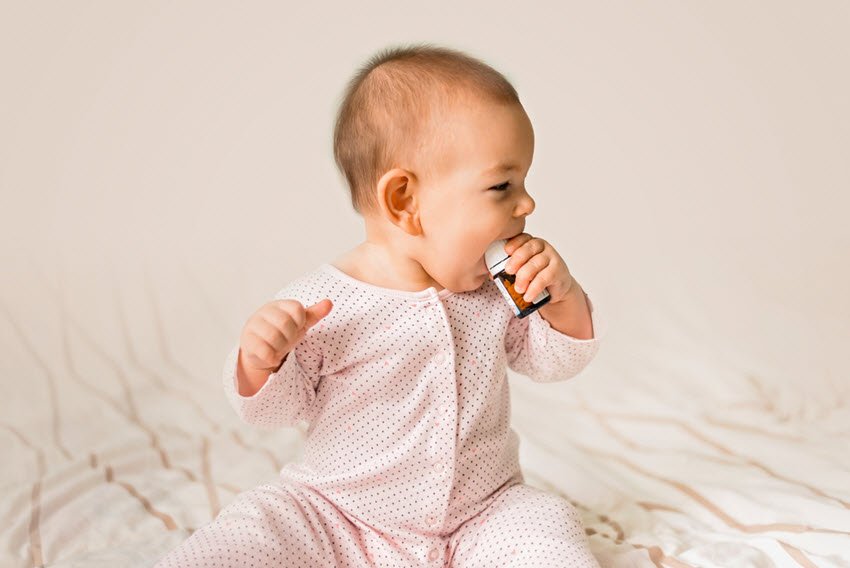
You may leave your medicine bottles on the bathroom counter so you don’t forget to take them. Doing so puts them in reach of children. Even if your bottle has a childproof cap, keep all medications on the top shelf of the medicine cabinet. You just never know what and when your child can get into your medications.
The same goes for bathroom toiletries. Kids are curious and will get into anything they can get their hands on. When in doubt, keep everything out of the reach of children on high shelves where they will not be able to reach them unless they have an incredible growth spurt overnight.
Consider using a locked, or childproof box to store your medicine in. That way you can keep it somewhere that’s convenient but safe from curious hands.
[amalinkspro type=”showcase” asin=”B01KVKMGBE” apilink=”https://www.amazon.com/dp/B01KVKMGBE?tag=mominformedcom-20&linkCode=osi&th=1&psc=1″ new-window=”true” addtocart=”false” nofollow=”true” sc-id=”4″ imgs=”LargeImage” link-imgs=”false” specs=”LOW TECH – Reliability, ease of use and overall quality. Lockabox One features a 3-digit combination code lock, stackable design and comes fully assembled ready to use.~~~POLYCARBONATE CONSTRUCTION – Hygienic, lightweight and versatile. Our products are made from an industry leading polycarbonate plastic suitable for food, medicines and sensitive household items. Lockabox One is also available in Crystal (clear), offering a unique combination of security and visibility.~~~COMPACT, PORTABLE AND CAN BE FIXED – Often described as a happy medium, Lockabox One is 2.8 gallons in volume and around the size of a large shoe box. It is easily transportable, can be placed inside a bedside cabinet or fixed to a wall, desk or shelf as required.~~~” btn-color=”#ff9900″ btn-text=”Buy on Amazon” alignment=”aligncenter” hide-prime=”0″ hide-image=”0″ hide-reviews=”0″ hide-price=”0″ hide-button=”0″ width=”750″]Lockabox One | Compact and Hygienic Lockable Box for Food, Medicines and Home Safety[/amalinkspro]
How to Childproof The Bedroom
When you look around your child’s bedroom, you may not notice anything that could pose a hazard. But, when you take a closer look, you’ll see the reasons why you need to childproof your home.
How to Childproof Dressers
View in gallery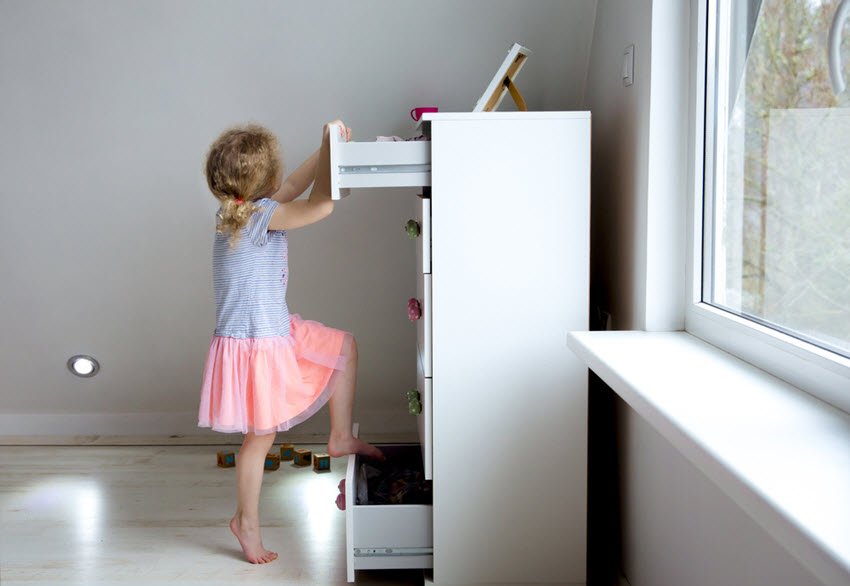
Dressers pose the same danger as televisions in the living room. They can tip over more easily than you think. A study done a few years ago found that a child is killed by a falling piece of furniture once every two weeks. Look around the bedroom and take a look at all dressers or any other pieces of furniture. They should be anchored to the floor or to the wall for safety. This can give you some peace of mind that your baby is safe in the bedroom.
[amalinkspro type=”showcase” asin=”B085W1SDRC” apilink=”https://www.amazon.com/dp/B085W1SDRC?tag=mominformedcom-20&linkCode=osi&th=1&psc=1″ new-window=”true” addtocart=”false” nofollow=”true” sc-id=”4″ imgs=”LargeImage” link-imgs=”false” specs=”【Best Choice of Anti-tip Strap】Are your kids safe at home? How to Create and maintain a safe environment for your kids and pets at home? the best choice is metal furniture straps secure furniture to the wall to help against furniture tipping over, even during earthquakes and windstorms~~~【Extra Strong Metal Furniture Straps】These furniture anti-tip kit are made with durable steel and structured under mechanical design, can easily withstand a load of up to 400 lbs. Perfect for anchoring TV stand, drawer, cabinets, bookcases, dresser, armoires, wardrobes, and any furniture~~~【Removable Furniture Anchors Cables】 The furniture wall strap cables have screw-closure design, so that the safety strap provides a positive and reliable lock when engaged and it’s easy to loosen if you want to move the furniture or do some cleaning. As the furniture strap anti tips are installed in the back, you cannot see the straps from the front but they may be visible from the sides.~~~” btn-color=”#ff9900″ btn-text=”Buy on Amazon” alignment=”aligncenter” hide-prime=”0″ hide-image=”0″ hide-reviews=”0″ hide-price=”0″ hide-button=”0″ width=”750″]Furniture Strap for Baby Proofing, Metal Child Proofing Anti-tip Furniture Anchors (6 Pack), Secure 400 Pound Falling Furniture Prevention Straps Child Pet Safety Straps Earthquake Resistant (6)[/amalinkspro]
How to Childproof Piggy Banks
If your child wants something they’re going to do everything in their power to reach it, which includes their piggy bank. While you may think the piggy bank is out of reach, your child may think that the height is just an obstacle to overcome and overcome he will.
Keep piggy banks in a place where your child won’t be tempted to grab it. If he does, it can smash to the ground not only increasing the chance your child will get cut, but also exposing coins. Your child may decide he wants to know what a penny tastes like. As you can imagine, that’s not going to end well. Keeping the piggy banks out of the way is just a better idea.
How to Childproof a Toy Box
The toy box is great to keep all of your child’s belongings in one place until the lid falls on their little fingers. Check to see if the lid has an automatic hinge. If it does, little fingers can get stuck easily. Look for hinge guards to protect those little hands.
How to Childproof a Crib
You may think that your child’s crib couldn’t harm then, but it can if you’re not careful. You’ll notice that the crib has different settings for the mattress. When your child is a newborn you can have it in the highest setting because your baby won’t have the strength to climb out.
As they get older and stronger, you’ll want to keep an eye on the mattress height. You’ll want to lower it so they won’t be able to climb out of the crib. Once they can stand up in the crib, whether it’s supported or not, you need to closely monitor the mattress height. As soon as you notice they can climb, it’s time to transition to a big kid bed.
Another thing to be on the lookout for in the crib are blankets, stuffed animals, and toys. While you may want to give your child his favorite blanket or stuffed animal at bedtime, don’t. Either of these can cause a suffocation risk.
How to Childproof a Bed
Once they reach big kid bed status, there is still a potential danger. Since they were always used to having rails on the crib, they may have trouble staying in their beds at first. That’s why it’s important to invest in safety rails. These provide protection for your child in case they rollover. While they’ll hit the safety rail, they won’t fall on the floor. This is important to have especially if their new bed is high off the ground.
[amalinkspro type=”showcase” asin=”B005EHNL3M” apilink=”https://www.amazon.com/dp/B005EHNL3M?tag=mominformedcom-20&linkCode=osi&th=1&psc=1″ new-window=”true” addtocart=”false” nofollow=”true” sc-id=”4″ imgs=”LargeImage” link-imgs=”false” specs=”SWING DOWN: The patented swing down feature allows this bedrail to pivot down and out of the way when getting in and out of bed or removing sheets~~~EXTRA LONG AND EXTRA SAFE: 54-inches long (hinge point) and 20-inch tall for added security~~~EASY TO SET UP: No tools required~~~SECURE: Anchoring strap that secures the bedrail to the bed. Designed with all steel frame~~~FIT: For use with a twin to queen size bed. PLEASE NOTE, ONLY for use with bed and box spring~~~Cover is machine washable.~~~” btn-color=”#ff9900″ btn-text=”Buy on Amazon” alignment=”aligncenter” hide-prime=”0″ hide-image=”0″ hide-reviews=”0″ hide-price=”0″ hide-button=”0″ width=”750″]Regalo Swing Down 54-Inch Extra Long Bed Rail Guard, with Reinforced Anchor Safety System[/amalinkspro]
How to Childproof Baby Mobiles
View in gallery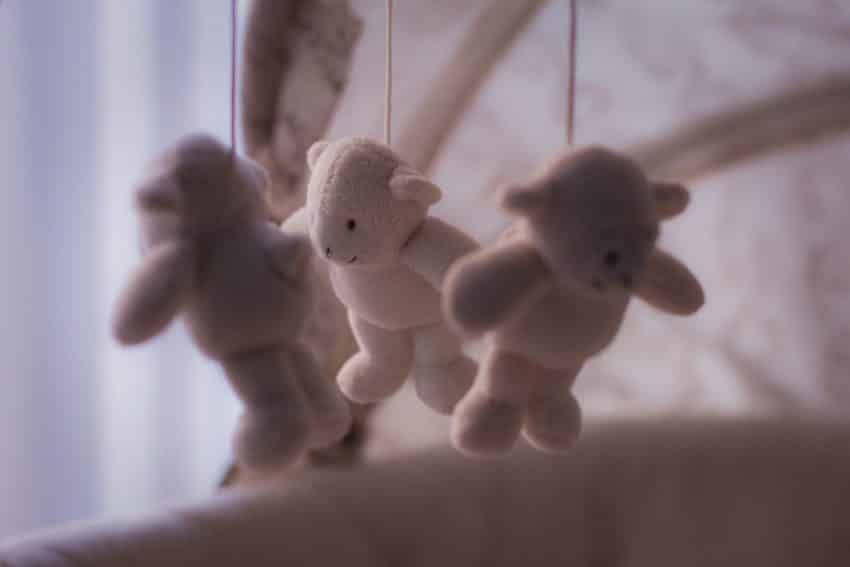
Baby mobiles are nice to have in the crib to keep your baby occupied. But, if the strings are too low, they can cause a strangulation hazard. Be sure they are high enough and out of reach for your baby.
How to Childproof a Changing Table
Most changing tables come with straps to keep your baby in place when you’re trying to get through a diaper change. But, when your baby is on the changing table, keep wipes, diaper cream, and anything else out of their reach. It just takes a quick second of you grabbing a diaper for them to get their hands on something they shouldn’t.
How to Childproof the Backyard or Front Yard
When the weather is nice, everyone wants to be outside. But, that doesn’t mean that children can’t get hurt outside as well. Besides your basic cuts and bruises, your yard could also pose a huge risk if you have a pool.
If you have a pool, you need to have a fence around it as well as a lock. The ladder locks that many above ground pools have are often not effective enough. If toddlers are mobile and climbing, they’ll find a way to climb that ladder even when it’s locked.
Securing the area around your pool with a fence and lock is the best way to prevent accidents. You always have to be sure that the gate is locked and closed, especially when no one is outside. Many people also install pool alarms so that they can hear when people may be getting near their pool when they’re not supposed to.
Any doors leading to the pool should also be locked at all times. There have been many tragic stories in the news when the child slips out the back door and into the yard where there is a pool. This further enforces the importance of having doorknob covers on doors so that kids can not open them.
If there are any sheds on your property, you’ll want to have those locked as well. If your child is walking, they can easily wander into them and get their hands on things they shouldn’t. Many people keep tools in their sheds. You wouldn’t want a child to get their hands on anything accidentally. Keeping a shed locked with a key is probably your best bet to keep your child safe outside.
View in gallery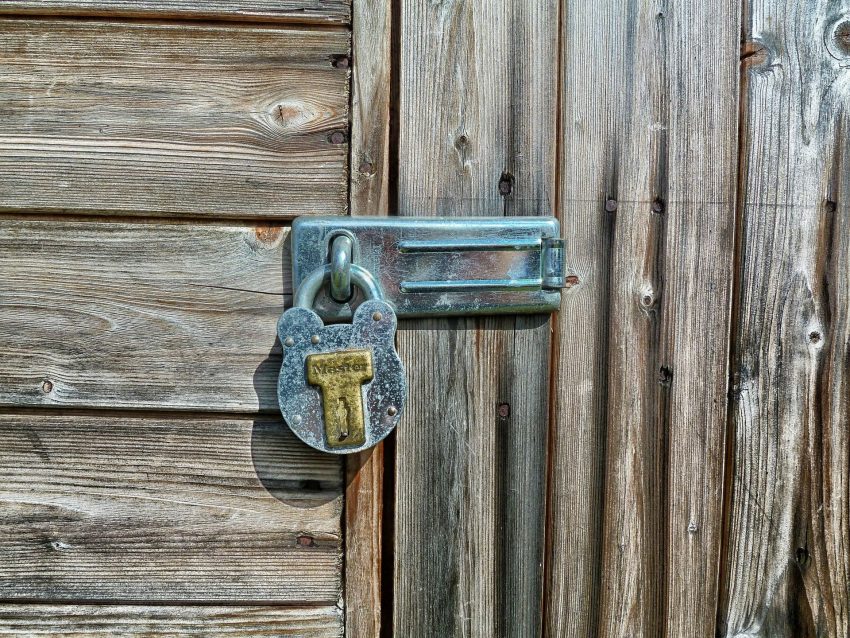
Also, if there are decks and patios that are not ground level, be sure that all entranceways are blocked with a gate. Keep children away from the edges of the deck or patio and be sure that they can’t put their hands or head in between any railings. Just because your head can’t fit between the rails doesn’t mean that applies to your child. They have smaller body parts that can become wedged in some of the worst places possible.
There are safety nets that you can purchase to prevent your child from getting any body parts stuck in between outdoor railings.
[amalinkspro type=”showcase” asin=”B06XW2W33F” apilink=”https://www.amazon.com/dp/B06XW2W33F?tag=mominformedcom-20&linkCode=osi&th=1&psc=1″ new-window=”true” addtocart=”false” nofollow=”true” sc-id=”4″ imgs=”LargeImage” link-imgs=”false” specs=”COVERAGE: This net stretches 30 feet in length~~~PEACE OF MIND: Provides a safety barrier for your children to prevent accidents~~~EASY TO INSTALL: Measure the length of your railing, cut the net to length, and attach with included tie straps. Instructions included as well.~~~DURABILITY: UV Protected to hold strong in the sun light.~~~Also available in 16 and 340 ft. models. Polypropylene outdoor netting.~~~” btn-color=”#ff9900″ btn-text=”Buy on Amazon” alignment=”aligncenter” hide-prime=”0″ hide-image=”0″ hide-reviews=”0″ hide-price=”0″ hide-button=”0″ width=”750″]Kidkusion Deck Guard – 30′ L x 34″ H – Made in USA – Outdoor Balcony and Stairway Deck Rail Safety Net – Clear – Child Safety; Pet Safety; Toy Safety[/amalinkspro]
Other Ways to Keep Your House Safe for Your Child
Besides going room by room, there are other ways to keep your child safe while you’re childproofing your home. Keeping a fire extinguisher handy, but out of the reach of children, is always a good idea. Grease fires can happen when you’re cooking. Other small fires can also happen at home. Having a fire extinguisher handy can prevent these tragedies from becoming larger ones.
[amalinkspro type=”showcase” asin=”B000EFQCKI” apilink=”https://www.amazon.com/dp/B000EFQCKI?tag=mominformedcom-20&linkCode=osi&th=1&psc=1″ new-window=”true” addtocart=”false” nofollow=”true” sc-id=”4″ imgs=”LargeImage” link-imgs=”false” specs=”Commercial-Grade Metal Valve and Trigger~~~U.S. Coast Guard approved~~~Metal pull pin with safety seal to deter accidental discharge~~~Easy-to-read pressure gauge~~~Bracket with strap for easy mounting~~~” btn-color=”#ff9900″ btn-text=”Buy on Amazon” alignment=”aligncenter” hide-prime=”0″ hide-image=”0″ hide-reviews=”0″ hide-price=”0″ hide-button=”0″ width=”750″]First Alert HOME1 ABC 2.5 Pound Rechargeable Fire Extinguisher-HOME1-1-A:10-B:C-10-Year Warranty, 1 Pack[/amalinkspro]
Another way to keep your child safe in your home is to become CPR certified. Despite all of your childproofing efforts, accidents do happen. Being CPR certified can help save your child’s life in case of an accident or the life of anyone visiting your home.
Here are some general tips and hacks for baby proofing your home:
The Bottom Line
When it comes to childproofing your home, it’s important to go room by room to make sure you’re not missing anything. If you think to yourself that your baby would never grab an object or never be able to reach something, think again. These are usually the spaces that get missed and end up causing an accident.
Most childproofing items are inexpensive and easy to install. Making yourself a checklist can assure that you don’t forget anything. If you haven’t had your baby yet, you can even register for their items. Many people would love to make a basket of safety items as a gift.
If you’re buying these items yourself, read the reviews and see what people are saying about them. Check out the ones we’ve highlighted here for great ideas to childproof your home. Also, take your time when installing all safety features in the home. Taking your time and following all directions can mean the difference between keeping your child safe and putting them in danger.
